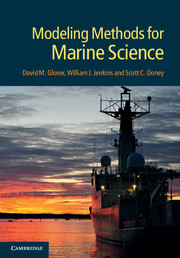Book contents
- Frontmatter
- Contents
- Preface
- 1 Resources, MATLAB primer, and introduction to linear algebra
- 2 Measurement theory, probability distributions, error propagation and analysis
- 3 Least squares and regression techniques, goodness of fit and tests, and nonlinear least squares techniques
- 4 Principal component and factor analysis
- 5 Sequence analysis I: uniform series, cross- and autocorrelation, and Fourier transforms
- 6 Sequence analysis II: optimal filtering and spectral analysis
- 7 Gridding, objective mapping, and kriging
- 8 Integration of ODEs and 0D (box) models
- 9 A model building tutorial
- 10 Model analysis and optimization
- 11 Advection–diffusion equations and turbulence
- 12 Finite difference techniques
- 13 Open ocean 1D advection–diffusion models
- 14 One-dimensional models in sedimentary systems
- 15 Upper ocean 1D seasonal models
- 16 Two-dimensional gyre models
- 17 Three-dimensional general circulation models (GCMs)
- 18 Inverse methods and assimilation techniques
- 19 Scientific visualization
- Appendix A Hints and tricks
- References
- Index
13 - Open ocean 1D advection–diffusion models
Published online by Cambridge University Press: 05 June 2012
- Frontmatter
- Contents
- Preface
- 1 Resources, MATLAB primer, and introduction to linear algebra
- 2 Measurement theory, probability distributions, error propagation and analysis
- 3 Least squares and regression techniques, goodness of fit and tests, and nonlinear least squares techniques
- 4 Principal component and factor analysis
- 5 Sequence analysis I: uniform series, cross- and autocorrelation, and Fourier transforms
- 6 Sequence analysis II: optimal filtering and spectral analysis
- 7 Gridding, objective mapping, and kriging
- 8 Integration of ODEs and 0D (box) models
- 9 A model building tutorial
- 10 Model analysis and optimization
- 11 Advection–diffusion equations and turbulence
- 12 Finite difference techniques
- 13 Open ocean 1D advection–diffusion models
- 14 One-dimensional models in sedimentary systems
- 15 Upper ocean 1D seasonal models
- 16 Two-dimensional gyre models
- 17 Three-dimensional general circulation models (GCMs)
- 18 Inverse methods and assimilation techniques
- 19 Scientific visualization
- Appendix A Hints and tricks
- References
- Index
Summary
Faith and doubt both are needed – not as antagonists, but working side by side to take us around the unknown curve.
Lillian SmithRationale
Our main objective in studying one-dimensional, open-ocean advection–diffusion models is pedagogical. The fact that they have relatively simple analytical solutions makes them a useful starting point for studying ocean models. In fact, you may find yourself turning to these more idealized representations as a tool for building intuition about the behavior of more complex models. That is, you might build a “model of your model” to explore what is happening within it. Perhaps more important to the student of modeling, they represent an elegant example of how we can use spatial distributions to illuminate underlying physical and biogeochemical dynamics.
They're not really considered “state-of-the-art”, having been extensively exploited by geochemists starting in the 1950s and used by others many decades before that. In truth, there are few parts of the ocean that can be regarded as truly satisfying the assumptions and requirements of this class of model. Even then it is highly debatable how generalizable the parameters derived from such models really are to the rest of the world. However, it is instructive to think of the abyssal ocean in terms of simple one-dimensional balances because it helps build intuition about open-ocean processes. Certainly it is an interesting historical stage in the evolution of geochemical ocean modeling, and has much to offer as a learning tool for understanding the process of ocean modeling.
- Type
- Chapter
- Information
- Modeling Methods for Marine Science , pp. 332 - 345Publisher: Cambridge University PressPrint publication year: 2011



